 |
  |
 |
  |
Infusing intellect and intent into dance: Moving Stories and Touching Tales - Dr. Sujatha Maringanti e-mail: sujathamaringanti@gmail.com Photos courtesy: Jonathan Hollander July 19, 2020 As the entire humanity is marching to the tune of a microbe, with life being the only negotiation to make, songs and stories are all humans can turn to. And the stories abound - of prayers and preaching, of fear and fate. Here is a story about unassuming individuals, who use their art and intent to usher in a positive, powerful, sustained and silent revolution in a world torn apart by hatred and conflict. A major axis around which the story revolves is the staggering 45-year dance career of Jonathan Hollander, the artistic director of Battery Dance Company with its mission - 'artistic excellence and social relevance.'  Dancing to Connect The Battery Dance Company's team with Jonathan Hollander at the wheel, descended on India for the tenth time, for a 3-week tour of 9 cities. In a whirlwind tour of just three days, Battery Dance dazzled Hyderabad with its varied hues of artistry in the form of workshops, talks, a spectacular performance and the screening of Moving Stories. The film Moving Stories evoked visceral reactions in the audience which included teachers, students, engineers, lawyers, scientists, IT professionals, accountants, art enthusiasts and a few dancers. A rare combination of the brilliant work of two teams - the dancers' team of the Battery Dance Company and the film makers' team at Wilderness Films - resulted in a sensitive film with a powerful message. It showcases Jonathan Hollander's Dancing to Connect program and the unrelenting efforts of his team of six teaching artistes: Tadej Brdnik, Robin Cantrell, Mira Cook, Clement Mensah, Sean Scantlebury and Lydia Tetzlaff. They work with marginalized communities, bring dance into the lives of youngsters at risk, unlock their potential and resolve the conflict - consequently, creating bonds that last beyond the duration of dance workshops. Director Rob Fruchtman, who shared the core values and the ethos of the dance company, joined forces with writer-producer Cornelia Ravenal, filmmaker Mikael Södersten and producer Wendy Sax, to chronicle the journey of a team of true artistes and passionate teachers.  'Shakti' at Hyderabad Inspirations They have a way of jumping at people from unexpected corners of life, catching them off guard, changing their perspectives and finally transforming lives. Jonathan had a fair share of them. He was always surrounded by artists of highest caliber, thinkers, philosophers, philanthropists, mavericks and game changers. As a four-year old boy growing up in Chevy Chase, Maryland, Jonathan skipped joyfully on the furniture and the staircase of their living room as his mother Joan Wolman Hollander, a concert-pianist, played 'Skipping Song' on a Steinway grand piano. Within a year, he started taking piano lessons, which he steadily continued for thirteen years, with Robert Parris, Charles Crowder and Ylda Novik. This early childhood music training was a significant formative influence on shaping Jonathan's artistry. Interestingly, dance did not present itself to him until much later in life. It was around him as a casual interest, in the form of social dance, folk dance and musical theater. He observed the artistry of Erika Thimey, as she taught dance to his mother and sister and he danced to a choreography of Carolyn Carlson when he attended a summer program at Interlochen Center for the Arts, as a piano and drama major. Mangoes to Manipuri dance Jonathan discovered a whole new lifestyle, outlook and philosophy during his three-month stay in India in 1968, with his host family - Nirupama and Sidharth Mehta and their children Anand and Nandita. His journey to India, as a 16-year old American Field Service Exchange Student, was a major milestone in his life. Early exposure to a new country, learning to make sense of its lifestyle, art and culture, had left an indelible impression on him and expanded his artistic horizon in an unforeseeable manner. While the simple lifestyle and the caring attitude of the host family provided a home away from home for Jonathan, its deep involvement with music, theatre and visual arts, facilitated Jonathan's exposure to Indian arts and philosophy. He was introduced to the graceful movements of Manipuri dance of the legendary Jhaveri sisters and the highly structured Bharatanatyam of Acharya Parvati Kumar and his senior disciple Sucheta Bhide. Precious friendships and bonds were made at this crucial point of a privileged American teenager's life, which served as anchors, inspired him to build cultural bridges and evolve into a global citizen and a thought leader. He continues to return to his source - to inspire and to get inspired. 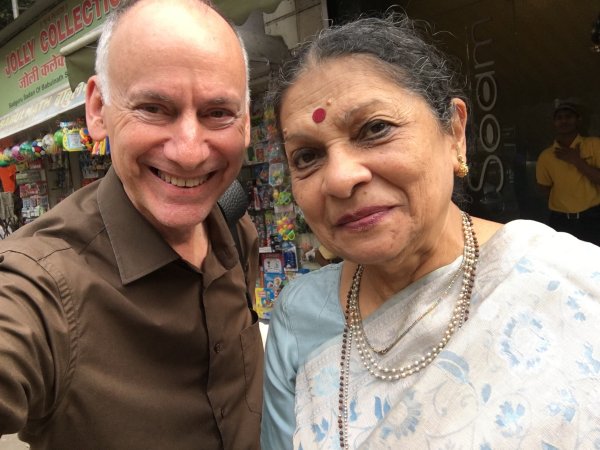 Jonathan with Darshana Jhaveri Soon after his return to the United States, Jonathan entered University of California, Irvine to study visual arts. It took a week of visual arts study, exposure to the multidisciplinary 'fine arts village' on the campus and wistful watching of dance students working on their routines on the campus lawns, for Jonathan to say "I want to do that" to dance! The transformation of Jonathan the pianist into Jonathan the dancer/choreographer had begun under the mentorship of none other than Eugene Loring, one of the pioneers of American ballet and a renowned choreographer. The ambience was perfect and the stage was set for a passing interest in dance to snowball into a full-blown passion. Luck smiled upon Jonathan and fabulous opportunities lined up for him in quick succession. Within a year of starting his dance lessons, Jonathan performed in Loring's original choreography, 'Folkdances of a Mythical Country'. A golden opportunity came calling when the legendary choreographer Merce Cunningham invited him on a scholarship to his New York City studio. At 19, Jonathan left academia and drove across the country to New York City, a mecca of dance opportunities, to pursue his new dreams. Influences When Merce Cunningham's "leap of faith" landed him in New York City in the early 1970s, Jonathan was just a beginner in terms of life, career and dance. New York City was reeling under recession and the socio-economic aspects of life were reflecting in art. The abandoned warehouses became the affordable abodes and incubators for writers, visual artists, musicians and dancers who successfully drove the transformation of the industrial neighborhoods into artists' enclaves. Despite the hardships, the city was brimming with intellectually stimulating, cross-disciplinary artistic works. It fostered a sense of community and created a perfect ambience for arts to flourish and evolve. 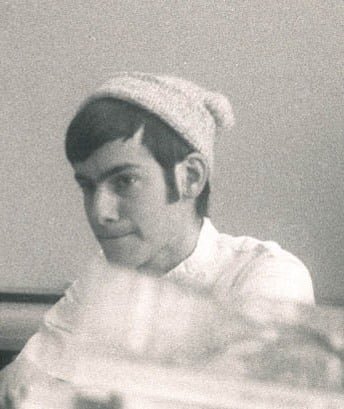 Young Jonathan The American Dance world had a clear demarcation between classical ballet and modern dance previously. But when Jonathan arrived in New York City, dancers, working on both sides of the fence, were emerging with new vocabularies by merging the classical and modern techniques. Radical approaches to movement by Merce Cunningham and his contemporaries challenged the fundamental structure and construct of dance and its performing space. These investigations opened flood gates to an era of experimental movement which stretched the very definition of a dance experience. Dances were created and performed away from the proscenium stage and on the sidewalks, lofts, museums, parks and churches. In the early part of his dance training in New York City, Jonathan had an opportunity to take part in one such dance 'Torelli', choreographed by Twyla Tharp, an extraordinary dancer known for taking artistic risks and innovative choreography. Torelli was part of a daylong performance with three segments in it: 'Sunrise', 'Midday March', and 'Evening Raga', performed at Fort Tyron Park, Battery Park and the City Hall respectively, covering the entire length of Manhattan. Jonathan's performance in Midday March was a formative experience which resonated well with his core values and artistic sensibilities. Similarly, the vivid images of New York public dance festival (1971) - where hundreds of people watched as the dancers performed against the backdrop of skyscrapers - remain etched in his mind. Along with the diverse socio-cultural atmosphere of New York City and its vibrant intellectual scene, the influence of extremely driven, powerful, unique and original creators such as Eugene Loring, Merce Cunningham, Arthur Mitchell and Twyla Tharp, had ignited the creative spark in Jonathan. Stepping out of the comfort zone to finding unique and unusual artistic niches, collaborating with people to consciously erasing the borders - a strong foundation for Battery Dance Company (BDC) was laid in downtown Manhattan. A sixth-floor loft on Stone Street was the incubator that Jonathan Hollander inhabited to embark upon an adventurous artistic journey that embraced communities and opened up the beautiful world of artistic possibilities. Thus, a unique dance company was born on Wall Street, as the historic ships docked along the waterfront and the fireworks lit the skies over Battery Park as part of the bicentennial celebrations. Institution If India inspired Jonathan to gain a global perspective, New York City influenced him to think local and put down roots. "Lack of art in lower Manhattan gave us a unique reason for being among the hundreds of other dance companies that already existed in New York. There was a territory that needed us and that gave us a sense of purpose right from the beginning," Jonathan explains in an interview to Huffington Post. He displayed an uncanny knack for strategic thinking and long-term planning from the early days of his career. "The neighbors in this financial district are banks, stock exchanges and brokerage houses, a propinquity that fits in with the designs of the company's founder, who has learned that the choreography of arts administration can often be as imaginative and almost as important as the choreography of the body." New York Times reports about Jonathan Hollander - "25 years old, lean, lissome and learned in the arts." 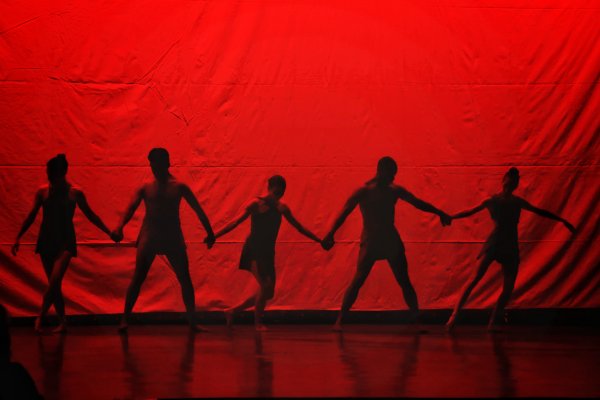 Joining Forces (Photo: Naveen Yadav) Faced with the challenge of drab financial neighborhood and lack of theatres, Jonathan turned corporate plazas, parks and piers into performing spaces. The dance team's performances attracted huge audiences, elicited positivity and goodwill in the neighborhood, which translated to partial funding from the neighbors. His first lessons in arts administration and management of funds were learnt while he waltzed with the Wall Street giants, including the New York Stock Exchange! "My first cultural diplomacy was in Wall Street and my audience was bankers, lawyers and accountants. An audience member does not have to be trained in the arts to think, feel, get inspired or enlightened by art," says Jonathan. Taking art into public sphere, instead of restricting it to a conventional black box theater with a few elite audiences, was a defining moment which opened up new artistic horizons in the organic evolution of the dance company. Three beautiful strands which address the mission of the company are carefully woven into the rich tapestry of Battery Dance's artistry. Battery Dance Festival: Started in 1982 as Downtown Dance Festival, it is now New York City's longest running outdoor, free public dance festival, a platform for original works of high artistic caliber from artistes around the globe. New York Season - Performance Series: An annual presentation of new work created by Battery Dance that has produced over 100 original works of varied themes and styles. Arts in Education Program: Started in 1984 in New York City public schools, it evolved into a key cultural diplomacy tool - Dancing to Connect program. "The people I chose to work with and who chose to join their energies with mine all had two things in common - maturity and meticulousness - in their approach to the art form of dance and concern for nurturing young people, especially those who hadn't had the same benefits in life that they'd had," says Jonathan about his team of dancers, technical experts, support staff and dedicated board members. 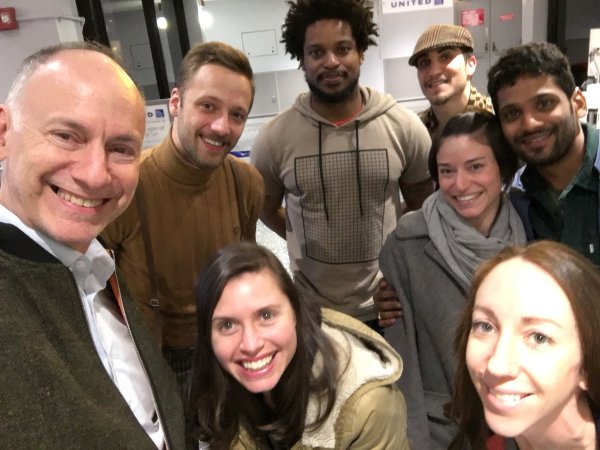 Jonathan and his dancers Intuition and Introspection "Dance made me understand my limitations," says Jonathan. His artistic journey was dotted with challenges which were affecting his dance, choreography and his ability to direct the dancers. Instead of dismissing or disconnecting, Jonathan chose to engage with and examine the fundamental flaws in his approach to art and the pedagogy, to intuitively arrive at decisive moments. A series of personal transformations led to changed perceptions, which then translated into external programs that benefitted not just the dance company but paved the path to understanding the deeper connection between movement and psyche. The resulting new approach was to see the beauty in human imperfection and to place trust in the heart of the individuals such that they find their inner well-springs of creativity, without the aid (or hindrance) of a pre-fabricated choreography. The choreography in this scenario, thus, becomes a collaborative, natural and organic process of simply unlocking the potential and self-expression. The success of this approach at Frank Sinatra School for the Arts in New York City encouraged Jonathan to take on an ambitious experimental project in Breisach, a small German town, in 2006. The venue was the site where a synagogue was burnt down in 1928 and most of the remaining members of the Jews of Breisach, perished at Auschwitz. The theme was coming to terms with the untouchable part of the history - Holocaust. The choreographers were high school children with no prior dance training! 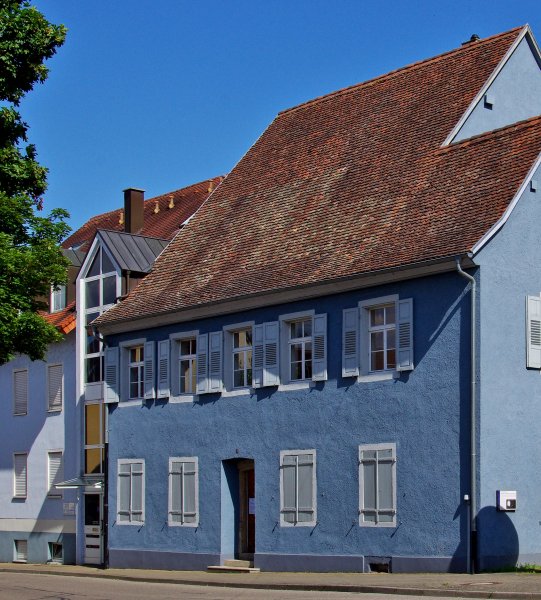 The Blue House Image courtesy: Wikimedia Commons Dr. Christiane Walesch-Schneller, a psychoanalyst and a non-Jewish member of the community of Breisach, who helped restore the Blue House to a museum and Aviva Geismar, the artistic director of Drastic Action, a New York based dance company and a descendant of Breisach Jews, collaborated with Battery Dance in this ambitious project. Over the course of 2 weeks, 12 teaching artistes from New York, Russia and Australia teamed up in pairs to work with groups of students from three public schools. The members of the community supported and provided the necessary perspectives and insights into the experimental project. The result of this extensive work - Dances for the Blue House - was a profound experience for everyone involved. "The German teens handled a complex theme such as Holocaust with maturity and created authentic, powerful, tear-jerking, poignant works in a non-verbal and kinesthetic way, which did not leave a dry eye in the audience," says Jonathan. The experience crystallized the process of eliciting powerful choreographic works from individuals in a short span of one week, when a safe and non-judgmental environment is created. Battery Dance has taught and utilized this methodology in over 60 countries to capture the imagination of youngsters, encourage team work, resolve conflict, break down barriers, build confidence and to promote unity among diverse groups. "Some kind of very deep human connection happens during this process. It is primal because it has to do with the body. It touches the deepest part of the brain and conscience, resulting in beautiful transformations," explains Jonathan. Access to arts, regardless of their socio-economic status was the core value which inspired the company to go on a mission, which now integrates working with children, dancers, teachers, stigmatized individuals, refugees and displaced people around the globe. No matter what the individual's circumstances, there is something that remains untouched and that is the dignity of the individual. Battery Dance recognizes and realigns individuals to this reality in a non-verbal, non-preaching and non-patronizing manner through movement, developing pathways for self-realization and creativity. In honor of his 'leadership in bringing together young people across borders through cultural exchange,' Jonathan Hollander was awarded Order of Merit of the Federal Republic of Germany - the highest tribute paid to individuals for services to the nation. India Every inspiration, influence and formative experience of Jonathan's life reflects in his impressive array of artistic work. India, however, has always remained the jewel in the crown. If the Jhaveri sisters' effortless dancing of exquisite Manipuri entranced the poet in young Jonathan, Sucheta Bhide's complex choreographies of Bharatanatyam enticed the philosopher in him. Smitten by the subcontinent at the age of sixteen, he embarked upon an ongoing exploration of the spirit of India and its dance forms. 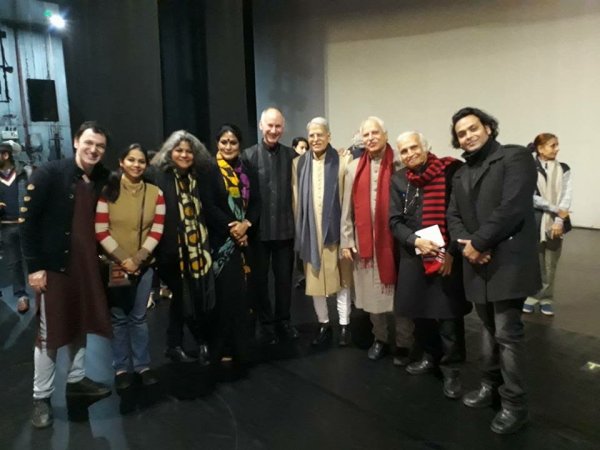 Jonathan with his collaborators Exquisite music - often commissioned and performed live - is the hallmark of Jonathan's choreographies, whether they are American or Indian. His cross-cultural creations started with Seen by a River with music by Indian jazz percussionist Badal Roy followed by Testimony of the Nataraja, with music by Badal Roy and Ken Wessel, the only non-Indian choreography within the production of Purush: Expressions of Man (1995). Purush underscored the strength and honest craftsmanship of male dancers. Songs of Tagore (1997) nudged Indian youth to appreciate the timeless poetry of the Bard of Bengal. Shakti: A Return to the Source (2018) draws its inspiration from Hindustani raag Durga, rendered by Rajan and Sajan Mishra. Jonathan connects, consults, collaborates and choreographs with senior scholars and stalwarts of Indian dance as well as young and upcoming bright dancers and theater practitioners. He co-founded Indo-American Arts Council (IAAC) in New York City and facilitated U.S. tours of over 80 Indian dancers. IAAC and Battery Dance jointly present Erasing Border Festival of Indian Dance to New Yorkers every summer for nine years, as a part of Battery Dance Festival, which since 2018, has continued to present its own annual India Day Program. One can only imagine the exuberance of audiences watching these magnificent dances - with the shimmering Hudson, an expansive sky and the Statue of Liberty as the backdrop! 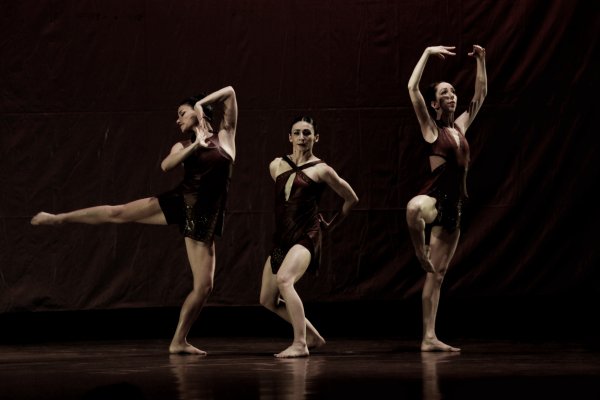 Shakti (Photo: Naveen Yadav) As the pandemic spreads, Jonathan wistfully watches through the large windows of his empty studios on Broadway. The streets look eerily similar to the era of 70's in which he made New York his home - neighborhoods shuttered, businesses suffering and some vanishing forever. Lives and livelihoods lost. Battery Dance paused…but only for a moment! The resilient New Yorker in Jonathan took charge and Battery Dance has gone virtual! Through Battery Dance TV - the brainchild of his super committed and tech savvy team - free Mindful Movement sessions for frontline healthcare workers, free dance classes and many more dance related programs are being offered for global audience. 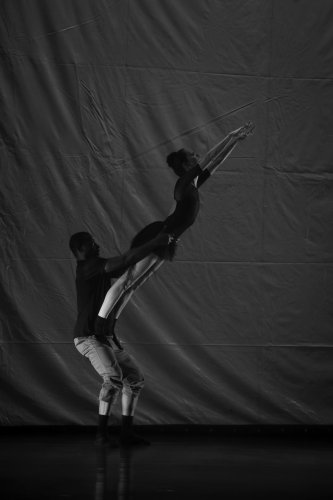 Leap for Joy (Photo: Naveen Yadav) Jonathan Hollander and the team at Battery Dance continue to inspire individuals around the globe and remain true to their mission of artistic excellence and social relevance. Here is an inspiration for those youngsters who choose dance over everything else! Dr. Sujatha Maringanti is a scientist and a lawyer based in Hyderabad. She is the founder of Art Can Happen Anywhere (ACHA) - a voluntary group of professionals and youngsters from various walks of life. ACHA aims to promote the appreciation of arts - dance, drama, music and storytelling and serves as a platform for young voices. Comments * It's an enlightening profile on Jonathan Hollander's meaningful work and encompassing philosophy. Erasing the borders, synergistic creative endeavors are the need of the hour. It is time for all creative people of the world to move in the direction of common good and at the least, to go less vehemently in self-glorification in art practice.. - Srinivas Chilakamarri (July 22, 2020) Post your comments Please provide your name and email id along with your comment. All appropriate comments posted with name and email id in the blog will also be featured in the site. |